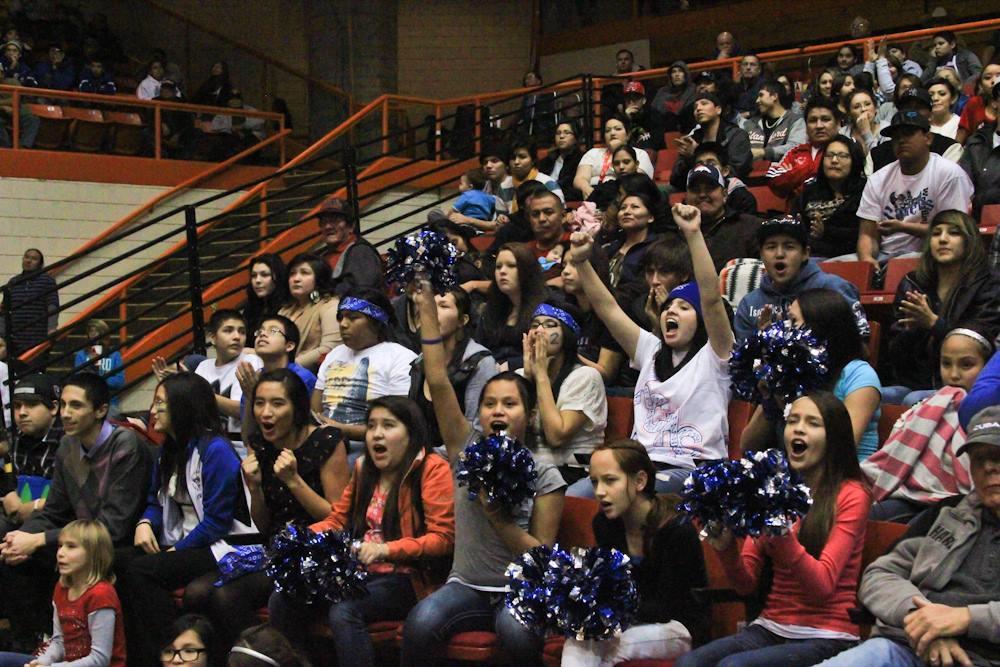
Spectators at the Lakota Nation Invitational. This year's event takes place December 16-19 at the Rushmore Plaza Civic Center in Rapid City, South Dakota. Photo from Facebook
From back page to front
Tracking the LNI the past 25 years
By James Giago Davies
Native Sun News correspondent There was a time when the acronym LNI meant nothing in Lakota country, when the Lakota Nation Invitational tournament was played before sparse crowds and was lucky to make the box scores of any local paper. Let’s look back over the past quarter century in intervals of five years, to see how the perception of the LNI changed. 1989
Even after the tournament became a fixture, when it was well into its second decade, LNI was still a tough acronym to spot in any newspaper. In 1989, the Custer Wildcats became the first non-Indian team to win the LNI, defeating defending champion Red Cloud, 59-53. This was hardly headline news: “Cats Capture Lakota title” was a small story in the middle of the page. But winning Custer coach Larry Luitjens spoke prophetically of what was to come. “This is the best tournament,” Luitjens said. “There is more atmosphere and pageantry in this tournament than there is in the state tournament. You know, the governor (the late George Mickelson) wants to call this a year of reconciliation between the Indians and Whites in South Dakota, but Bryan Brewer and Chuck Cuny started that three years ago when they invited us to this tournament.” For two years Custer ran into a wall of defense, and they lost both times, even though they went all the way to the state finals in 1989. Back in the 1960’s, when Pine Ridge had the great Will Garnier, and had to play in the big school top tier,” Thorpes coach Charles Gustafson complained, when his team lost to Rapid City in the 1966 sectional championship, of biased officiating. Racism against Lakota has been documented in our court systems, we see it in the reaction of fans, and so it stands to reason officiating would be equally tainted by it. But at the LNI the racist whistle does not determine winners and losers, any non-Indian team will have to win the game on the floor, applying strategy and skill, and Custer manned-up, took their lumps the first two years, before finally getting over the hump in 1989. They beat Red Cloud with tough defense, as Justin Wahlstrom shut down Rich Cuny, who had been Red Cloud’s leading scorer in the tournament. In a grueling back and forth struggle, Custer was up 11-9 after the first quarter, with Red Cloud fighting back on Beau LeBeau’s 3-pointer, to take a 16-15 lead in the second quarter. Lance Luitjens canned his own 3-pointer with 4:06 remaining in the half, and Custer stayed about five points ahead for the remainder of the game. LeBeau hit another 3-pointer late in the final quarter, followed by a bucket from teammate Jude Fairbanks, which cut the Wildcat lead to 56-53, but foul trouble set in, and LeBeau, Cuny and Ruben Brown, fouled out. Many see Indian basketball as being mostly about scoring, not defending, and however true or untrue that might be, the LNI continually rewards tough defensive teams over high scoring teams. “We played good defense,” Red Cloud Coach Dusty LeBeau said. “Although some don’t give us credit for it. These kids deserve some credit. They played an outstanding ball club. There won’t be many teams that will come as close to them as we did.”

Read the rest of the story on the all new Native Sun News website: From back page to front (James Giago Davies can be reached at skindiesel@msn.com) Copyright permission Native Sun News
Join the Conversation
